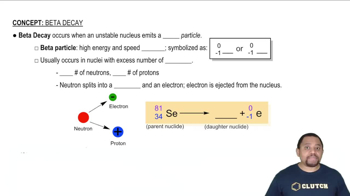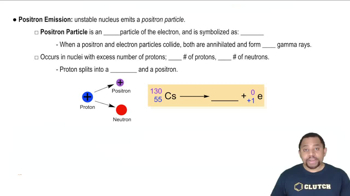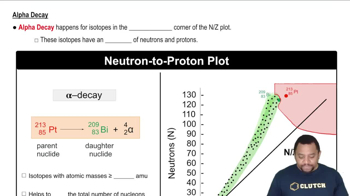Here are the essential concepts you must grasp in order to answer the question correctly.
Beta Decay
Beta decay is a type of radioactive decay in which a nucleus emits a beta particle, which can be an electron (beta-minus decay) or a positron (beta-plus decay). In beta-minus decay, a neutron is converted into a proton, increasing the atomic number by one, while in beta-plus decay, a proton is converted into a neutron, decreasing the atomic number by one. This process helps unstable nuclei achieve a more stable configuration.
Recommended video:
Positron Emission
Positron emission, also known as beta-plus decay, occurs when a proton in the nucleus is transformed into a neutron, releasing a positron (the antimatter counterpart of an electron) and a neutrino. This process decreases the atomic number of the element by one, resulting in the formation of a different element. Positron emission is common in isotopes that are proton-rich and seek stability.
Recommended video:
Nuclear Stability and Decay Modes
Nuclear stability is determined by the ratio of protons to neutrons in a nucleus. Isotopes with an imbalance in this ratio may undergo decay to reach a more stable state. The type of decay—whether beta decay or positron emission—depends on whether the nucleus has excess neutrons or protons. Understanding the stability of a nucleus is crucial for predicting its decay mode.
Recommended video:
Band of Stability: Alpha Decay

 Verified step by step guidance
Verified step by step guidance


